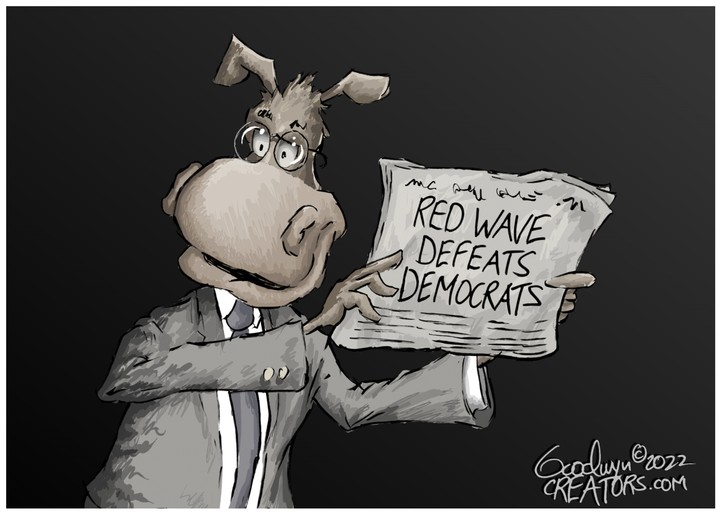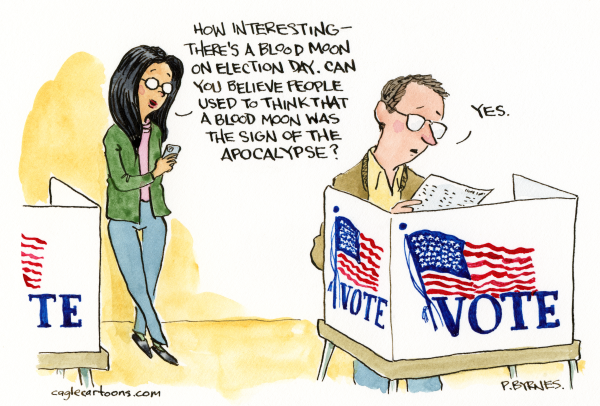 "Election Day" coverage continues today into its second week on BradCast, as more of the closest races are being called and as a clearer picture emerges as to what actually happened and why. [Audio link to full show follows this summary.]
"Election Day" coverage continues today into its second week on BradCast, as more of the closest races are being called and as a clearer picture emerges as to what actually happened and why. [Audio link to full show follows this summary.]
Shortly after airtime on Monday night, media outlets finally called the very close Arizona Governor's race for Democratic Sec. of State Katie Hobbs over former TV news anchor and failed Trump-wannabe Kari Lake. As we detail, Lake's apparent narrow loss was likely particularly satisfying for outgoing GOP Rep. Liz Cheney.
Hobbs' lead over Lake, with almost all votes tallied, is 0.7% as we go to air. That is above the 0.5% or less required for an automatic recount in AZ, where state law (shamefully) does not allow for candidates to request and pay for a recount on their own. That, of course, will allow Lake to continue to present evidence-free claims of "fraud" in her election, particularly given unexplained Election Day failures of some optical scanner at some polling places in Maricopa County. That shouldn't have prevented anybody from voting --- thankfully, Arizona votes on hand-marked paper ballots --- but it did mean that some ballots cast at the polls on Election Day had to be tabulated back at County headquarters later.
Presuming Hobbs' victory is certified as expected, that means the AZ's Governor's office turns from "red" to "blue" for the first time in 13 years. (It'll be the third state where that happened this year.) Add to that the state's two Democratic U.S. Senators and Democrat Adrian Fontes' victory over Trump-backed election liar Mark Finchem for Sec. of State, and Democrat Kris Mayes currently leading Republican Abe Hamadeh (if barely --- and easily within recount territory for now) in the race to replace the state's outgoing Republican Attorney General. All of that looks a lot like a new "blue" state, with every major statewide seat in AZ perhaps soon to be occupied by a Democrat in advance of 2024.
Yes, it was a stunning midterm election across the nation, as that "red wave" that Republicans and corporate media imagined and promised, never arrived.
"This is the best midterm election result for a newly-elected Democratic President in their first term since Franklin Delano Roosevelt in 1934," notes our guest today, progressive journalist and author JOHN NICHOLS of The Nation, describing the results as "remarkable" and "against all sorts of historical patterns," while observing that this is the "third election cycle in a row where Donald Trump has been the dominant figure in the Republican Party and the Republican Party has lost. It's kind of a pattern."
So why did the results defy history? "I think the answer is that our politics have changed. We're not in the same world that we were in before," explains Nichols, who we have turned to many times over the years following Election Days to try and make sense of them. "Local media doesn't exist the way it used to, so elections are nationalized. We have seen the two parties go more to their corners --- the Democrats at least somewhat to the left, Republicans way to the right --- so we have to adjust our filter. And if we do, we understand that this election actually tells us a lot about where potential Democratic majorities and coalitions are in the future."
We dig deep into the remarkable results and how they may have been even better for the Democrats had the party not been so taken by their own fears that the media might have been right about the "red wave" which never came. Those poor predictions (which often contradicted the media's own available evidence to the contrary) also resulted in an overconfident GOP which, like the Democrats, ended up spending money in many of the wrong races. Nichols explains how Dem victories might have been even broader had they fought more aggressively and less defensively by funding, for example, more rural races where Democrats could have also won with more support from the Party.
He breaks down the likely reasons that the excellent Democratic candidate Mandela Barnes, in Nichols home state of Wisconsin, ended up losing to the insufferable Republican insurrection enthusiast Sen. Ron Johnson, and why other excellent candidates, if arguably less progressive ones, like Tim Ryan in Ohio and Cheri Beasley in North Carolina, ended up falling short.
In addition we also dig into how critical young voters --- lots of them! --- were to what ultimately happened this year. "Young people ought to be where you're putting a lot of your resources. As a party, Democrats need to be talking to young voters, bringing young people into leadership positions in the party. If you do, the rewards are immense," he avers. "Under 30 and especially under 25, the bias is 28% in favor of the Democrats. At the very end of the 2022 cycle, in states across the country, you had a lot of young voters lining up and casting votes. They don't turn out at the same percentage, at the same level, as older voters do. But if they turn out strong, it has a huge impact."
We also discuss how an institutionalist like Joe Biden has been clever enough as President to shift his policies toward the progressive left, in tune with those voters and the American electorate overall.
"Let's be very clear," Nichols argues today, "despite what games pundits try to play, Americans had a very clear choice. In 2022, they had a choice between an extreme rightwing Republican Party straying toward authoritarianism on many issues and a Democratic Party that was edging toward progressivism, and was attacked for that. And what did the American people decide to do? In a surprise to everyone, to the politicians and the pundits, they decided to go for the party that is edging towards progressivism."
Finally today, we close with Desi Doyen and our latest Green News Report, as Biden pledges leadership and funding at the U.N. climate conference in Egypt, and restarts climate negotiations with China...
(Snail mail support to "Brad Friedman, 7095 Hollywood Blvd., #594 Los Angeles, CA 90028" always welcome too!)
|


 Trump Already Violating Law (He Signed!) During Transition: 'BradCast' 11/18/24
Trump Already Violating Law (He Signed!) During Transition: 'BradCast' 11/18/24 Sunday 'Into the Gaetz of Hell' Toons
Sunday 'Into the Gaetz of Hell' Toons Computer Security Experts Ask Harris to Seek Hand-Counts Due to Voting System Breaches: 'BradCast' 11/14/24
Computer Security Experts Ask Harris to Seek Hand-Counts Due to Voting System Breaches: 'BradCast' 11/14/24  'Green News Report' 11/14/24
'Green News Report' 11/14/24
 Trump Criminal Cases Fade After Election as GOP 'Does Not Believe in Rule of Law': 'BradCast' 11/13/24
Trump Criminal Cases Fade After Election as GOP 'Does Not Believe in Rule of Law': 'BradCast' 11/13/24 Climate Advocates Brace for Fight With Trump 2.0: 'BradCast' 11/12/24
Climate Advocates Brace for Fight With Trump 2.0: 'BradCast' 11/12/24 'Green News Report' 11/12/24
'Green News Report' 11/12/24 Let It All Out: 'BradCast' 11/11/24
Let It All Out: 'BradCast' 11/11/24 Sunday 'Like it or Not' Toons
Sunday 'Like it or Not' Toons Not All Bad: Abortion Rights Won Big (Almost) Everywhere: 'BradCast' 11/7/24
Not All Bad: Abortion Rights Won Big (Almost) Everywhere: 'BradCast' 11/7/24 'Green News Report' 11/7/24
'Green News Report' 11/7/24 U.S. CHOOSES CONVICTED CRIMINAL, ADJUDICATED RAPIST: 'BradCast' 11/6/24
U.S. CHOOSES CONVICTED CRIMINAL, ADJUDICATED RAPIST: 'BradCast' 11/6/24 ELECTION DAY 2024: Tea Leaves, Probs for Voters, What's Next: 'BradCast' 11/5/24
ELECTION DAY 2024: Tea Leaves, Probs for Voters, What's Next: 'BradCast' 11/5/24 'Closing Arguments' for Undecideds, Third-Party Voters: 'BradCast' 11/4/24
'Closing Arguments' for Undecideds, Third-Party Voters: 'BradCast' 11/4/24 The GOP 'Voter Fraud' Before the Storm: 'BradCast' 10/31/24
The GOP 'Voter Fraud' Before the Storm: 'BradCast' 10/31/24 'Closing Arguments'with Digby and Driftglass: 'BradCast' 10/30/24
'Closing Arguments'with Digby and Driftglass: 'BradCast' 10/30/24 Trump Promises to be a Lawless, Authoritarian President. Believe Him: 'BradCast' 10/29/24
Trump Promises to be a Lawless, Authoritarian President. Believe Him: 'BradCast' 10/29/24 Ballots Burn, Billion-aires 'Obey in Advance', Callers Ring In: 'BradCast' 10/28/24
Ballots Burn, Billion-aires 'Obey in Advance', Callers Ring In: 'BradCast' 10/28/24 Musk's Privatized Internet Satellite System Threatens U.S. National Security
Musk's Privatized Internet Satellite System Threatens U.S. National Security
 VA GOP VOTER REG FRAUDSTER OFF HOOK
VA GOP VOTER REG FRAUDSTER OFF HOOK Criminal GOP Voter Registration Fraud Probe Expanding in VA
Criminal GOP Voter Registration Fraud Probe Expanding in VA DOJ PROBE SOUGHT AFTER VA ARREST
DOJ PROBE SOUGHT AFTER VA ARREST Arrest in VA: GOP Voter Reg Scandal Widens
Arrest in VA: GOP Voter Reg Scandal Widens ALL TOGETHER: ROVE, SPROUL, KOCHS, RNC
ALL TOGETHER: ROVE, SPROUL, KOCHS, RNC LATimes: RNC's 'Fired' Sproul Working for Repubs in 'as Many as 30 States'
LATimes: RNC's 'Fired' Sproul Working for Repubs in 'as Many as 30 States' 'Fired' Sproul Group 'Cloned', Still Working for Republicans in At Least 10 States
'Fired' Sproul Group 'Cloned', Still Working for Republicans in At Least 10 States FINALLY: FOX ON GOP REG FRAUD SCANDAL
FINALLY: FOX ON GOP REG FRAUD SCANDAL COLORADO FOLLOWS FLORIDA WITH GOP CRIMINAL INVESTIGATION
COLORADO FOLLOWS FLORIDA WITH GOP CRIMINAL INVESTIGATION CRIMINAL PROBE LAUNCHED INTO GOP VOTER REGISTRATION FRAUD SCANDAL IN FL
CRIMINAL PROBE LAUNCHED INTO GOP VOTER REGISTRATION FRAUD SCANDAL IN FL Brad Breaks PA Photo ID & GOP Registration Fraud Scandal News on Hartmann TV
Brad Breaks PA Photo ID & GOP Registration Fraud Scandal News on Hartmann TV  CAUGHT ON TAPE: COORDINATED NATIONWIDE GOP VOTER REG SCAM
CAUGHT ON TAPE: COORDINATED NATIONWIDE GOP VOTER REG SCAM CRIMINAL ELECTION FRAUD COMPLAINT FILED AGAINST GOP 'FRAUD' FIRM
CRIMINAL ELECTION FRAUD COMPLAINT FILED AGAINST GOP 'FRAUD' FIRM RICK SCOTT GETS ROLLED IN GOP REGISTRATION FRAUD SCANDAL
RICK SCOTT GETS ROLLED IN GOP REGISTRATION FRAUD SCANDAL VIDEO: Brad Breaks GOP Reg Fraud Scandal on Hartmann TV
VIDEO: Brad Breaks GOP Reg Fraud Scandal on Hartmann TV RNC FIRES NATIONAL VOTER REGISTRATION FIRM FOR FRAUD
RNC FIRES NATIONAL VOTER REGISTRATION FIRM FOR FRAUD EXCLUSIVE: Intvw w/ FL Official Who First Discovered GOP Reg Fraud
EXCLUSIVE: Intvw w/ FL Official Who First Discovered GOP Reg Fraud GOP REGISTRATION FRAUD FOUND IN FL
GOP REGISTRATION FRAUD FOUND IN FL



























 Welp, Election 2022 continues into its second week of counting on today's
Welp, Election 2022 continues into its second week of counting on today's 
 On today's
On today's  On today's
On today's 
 Republicans and corporate media appeared to be shocked on Tuesday night. But it looks like we had it right all along on
Republicans and corporate media appeared to be shocked on Tuesday night. But it looks like we had it right all along on  On today's Midterm Elections Day 2022
On today's Midterm Elections Day 2022 
 We try (though don't always necessarily succeed) to lighten things up a bit on today's
We try (though don't always necessarily succeed) to lighten things up a bit on today's 
 After a few quick words about the
After a few quick words about the  Today on
Today on 














